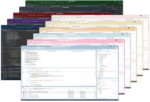Microsoft just shipped Visual Studio 2010 (VS 2010) last week, and while it was well received, leading .NET programming experts are already brainstorming about what features they would like to see come next.
“VS 2010 is a big release—more so than 2008,” said Larry O’Brien, a private consultant and author of the “Windows & .NET Watch” column for SD Times. Visual Studio’s new Windows Presentation Foundation (WPF) interface has made it easier for Microsoft to evolve the environment and for third parties to build plug-ins, he explained.
Consequently, there will be greater uptake of third-party solutions such as JetBrains’ ReSharper, and potentially more point updates to Visual Studio than there have been in the past, O’Brien said.
Roger Jennings, OakLeaf Systems developer and author of over 30 books on Windows development topics, praised VS 2010’s templates for creating and deploying Azure platform projects. The templates offer choices for creating ASP.NET, ASP.NET MVC and WCF Service Web roles, he said.
However, he found fault in how the experience is not entirely seamless: Developers must write PowerShell build scripts to securely deploy SSL and other certificates for Windows Azure, he said.
Other issues cited by Jennings involve the completeness of the user experience. Microsoft could improve VS 2010 by making its installation more comprehensive, improving load speeds of dialogs, adding spell-checking for comment and string assignments, and enabling its debugger and IntelliSense code complete for the Text Template Transformation Toolkit, he said.
“Microsoft has hit its stride with Visual Studio on the .NET Framework,” said Patrick Hynds, president of consulting firm CriticalSites and a Microsoft regional director (recognized by Microsoft for technical expertise). “There are a lot of great enhancements. The tooling is starting to catch up [with the framework.]”
However, there should be feature parity with Expression Blend in the next version of Visual Studio, he suggested. Expression Blend is an interface development tool that facilitates collaboration among clients, designers and developers. Developers are “jumping back and forth” to access resource dictionaries in Blend, he explained. “It would be great if the [Expression] designer role could dock and be part of Visual Studio.”
Hynds said that developers will likely “have to live with” several evolutions of Microsoft’s data access technologies as Microsoft builds out its ADO.NET Entity Framework.
Tim Huckaby, a Microsoft regional director and founder of consultancy group InterKnowlogy, also expressed a desire for feature parity among all of the .NET Framework versions. Silverlight, he suggested, should be able to “trickle download” (or download components as needed) the entire .NET Framework instead of being a small subset of WPF.
“And I want parity in platforms and devices,” he added. “We are getting close with Silverlight native on the [Windows Phone 7], but we are not in ‘write once, run everywhere’ nirvana yet.”
More for the look and feel
The experts also gave significant consideration to improving the user experience within both Silverlight and WPF applications.
Additional themes and designs would make it easier for developers to write Silverlight and WPF applications, said Andrew Brust, a Microsoft regional director and chief of new technology at consultancy firm twentysix New York. Developers should not have to “muck with” raw Extensible Application Markup Language (XAML) code unless they want to, he explained. “What I hope for in [Visual Studio 11] and .NET 5 is added simplicity and much higher productivity.”
Templates would “relieve much of the tedium” in setting up an application shell, said author and Microsoft regional director Billy Hollis. “The current Silverlight Navigation Application template is an example of what I’m talking about, but it is way too simple and doesn’t use XAML layout capabilities effectively.”
Visual Studio has room to grow when it comes to designing interfaces wholly in XAML, according to Hollis. “VS 2010 was a big leap in that respect, but the visual designers in VS 2010 are still oriented around easing the transition for people coming from older drag-and-drop environments. I want to see visual designers optimized for the way XAML-base interfaces need to be constructed,” he said.
Microsoft could address its shortcomings by offering different modes for different levels of XAML programming experience, Hollis suggested. “Someone who understands XAML’s composition model should not have to put up with the stuff the designer inserts in an attempt to help less-experienced users coming from older technologies. And those advanced users need template editing and other features that we currently have to use Expression Blend to get to today.”
Today’s mainstream IDEs may be nearing the end of their evolutionary path, O’Brien said. “You can edit, jump around between files, compile and debug. You have a lot of panes, you can arrange them, etc. That can’t be all there is to creating software.”
Radical thinking is needed in terms of IDEs and code construction, he explained. He cited Code Bubbles, a Brown University research project, as an original approach to rethinking IDE user interfaces. “I personally don’t think that’s ‘the’ solution to code editing, but I admire the originality.”
Transitioning Visual Studio to WPF as the underlying platform for Visual Studio opens it up to broader possibilities for visualizers and other interaction patterns in the IDE, Hollis said. “In this version, the objective was simply to get to the new WPF platform. I hope the team gets a lot more ambitious for the next generation.
“In particular, I hope the people doing interaction design for the next Visual Studio move beyond thinking of the IDE as a collection of rectangles that stuff gets poured into,” he continued. “There is enormous room to use the capabilities of WPF to craft much richer, more interactive developer experiences in the IDE.”




